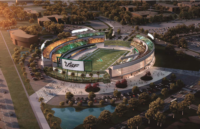Major League Baseball's Tampa Bay Rays and the city of St. Petersburg, Fla., are joining in a public-private partnership to build a $1.3-billion ballpark, surrounded by a mini-city, with 8 million sq ft of mixed-use development. The undertaking, in the works for 16 years and announced Sept. 19, is expected to anchor a total of more than $6.5 billion in construction at the 86-acre site, over 20 years.
Hines Historic Gas Plant Partnership, led by Houston-based developer Hines, will spearhead the project. The goal is to revitalize St. Petersburg’s historic Gas Plant District, an African American neighborhood that suffered displacement when the city constructed Tropicana Field in the late 1980s. Plans call for residential, office, meeting, hotel and retail space, a museum and civic and open space.
At a briefing, Jeff Hines, Hines chairman and co-CEO called the development a “city-defining project.”
Last year, Hines replied to a request for proposals (RFPs) from St. Petersburg Mayor Ken Welch last year. The public approvals process, with the city and Pinellas County, is expected to begin this fall. A construction start for the ballpark, which is phase one of the megadevelopment, is scheduled for late 2024. The team will continue to play at Tropicana Field until its current lease with St. Petersburg expires in 2027. The aim is to finish the new ball field in time for opening day in 2028.
The Rays have committed to pay for more than half the $1.3-billion cost of the field. They will also be responsible for any cost overruns, according to an announcement from St. Petersburg, which along with Pinellas County, will split the remaining $600 million.
According to Hines’ presentation to the St. Petersburg City Council in December 2022, Dantes Partners of Washington, D.C., will lead the development of affordable housing and assist Hines with residences elsewhere. Gensler is the master plan architect, with the local Storyn Studio for Architecture. Kimley-Horn, which the presentation says has worked extensively with the Rays and St. Petersburg, will provide engineering services for the site.
Ballpark Plans
Plans by architect Populous call for a 30,000-seat ballpark with the ability to expand to 35,000 for other events. The ballpark will be enclosed and air-conditioned with transparent walls that open and close, according to the announcement. The roof won't retract, but plans call for operable windows just below the roofline.
Aside from the ballpark, plans call for:
- 4,800 residential units
- 1,200 on- and off-site affordable/workforce units
- 600 senior living units
- 1.4 million sq ft of office, medical and commercial space
- 750,000 sq ft of retail space
- 750 hotel rooms
- 100,000 sq ft of entertainment space including concert venue seating up to 4,000
- 50,000 sq ft of civic space including new home for Carter G. Woodson African American Museum
- 90,000-100,000 sq ft of conference, ballroom and meeting space
- 14 acres of open space
- 14,000 parking spaces
According to the city, the plan calls for equitable, intentional and restorative development, including affordable housing units and affordable senior living units.
“The City of St. Pete’s 23 guiding principles as laid out in the RFP provided the necessary framework towards the path of creating a home where everyone has the means, infrastructure and tools to stay,” said Anddrick Frazier, president and CEO of Best Source Consulting, which spearheaded an intentional equity program for the project.
That began with a $50-million investment for intentional equity to South St. Petersburg, he said, and from the Hines Historic Gas Plant Partnership commitment to spend $500 million in supplier diversity.
Estimates are that the project would create at least 4,500 construction jobs and 15,000 annual jobs, according to Janet Long, chair of the Pinellas County Board of Commissioners.




Post a comment to this article
Report Abusive Comment